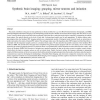Free Online Productivity Tools
i2Speak
i2Symbol
i2OCR
iTex2Img
iWeb2Print
iWeb2Shot
i2Type
iPdf2Split
iPdf2Merge
i2Bopomofo
i2Arabic
i2Style
i2Image
i2PDF
iLatex2Rtf
Sci2ools
NN
2000
Springer
2000
Springer
Synthetic brain imaging: grasping, mirror neurons and imitation
The article contributes to the quest to relate global data on brain and behavior (e.g. from PET, Positron Emission Tomography, and fMRI, functional Magnetic Resonance Imaging) to the underpinning neural networks. Models tied to human brain imaging data often focus on a few "boxes" based on brain regions associated with exceptionally high blood flow, rather than analyzing the cooperative computation of multiple brain regions. For analysis directly at the level of such data, a schema-based model may be most appropriate. To further address neurophysiological data, the Synthetic PET imaging method uses computational models of biological neural circuitry based on animal data to predict and analyze the results of human PET studies. This technique makes use of the hypothesis that rCBF (regional cerebral blood flow) is correlated with the integrated synaptic activity in a localized brain region. We also describe the possible extension of the Synthetic PET method to fMRI. The second ...
| Added | 19 Dec 2010 |
| Updated | 19 Dec 2010 |
| Type | Journal |
| Year | 2000 |
| Where | NN |
| Authors | Michael A. Arbib, Aude Billard, Marco Iacoboni, Erhan Oztop |
Comments (0)

